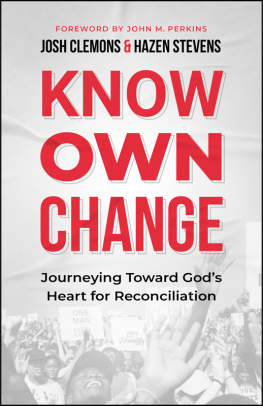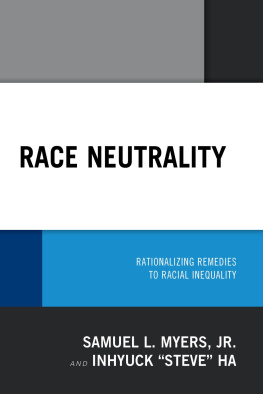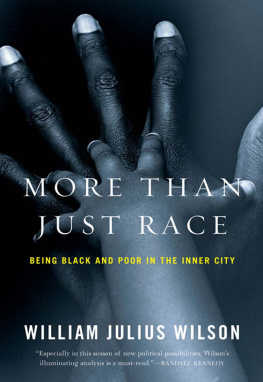Published by Louisiana State University Press
Copyright 2019 by Louisiana State University Press
All rights reserved
Manufactured in the United States of America
Designer: Michelle A. Neustrom
Typeface: Chaparral Pro
Library of Congress Cataloging - in - Publication Data
Names: Grimm, Josh, 1980 editor. | Loke, Jaime, 1979 editor.
Title: How public policy impacts racial inequality / edited by Josh Grimm and Jaime Loke.
Description: Baton Rouge : Louisiana State University Press, [2019] | Series: Media and public affairs | Includes index.
Identifiers: LCCN 2018052210| ISBN 978-0-8071-7070-0 (pbk. : alk. paper) | ISBN 978-0-8071-7168-4 | ISBN 978-0-8071-7169-1
Subjects: LCSH: United States Social policy. | United States Race
relations. | Racism United States. | Discrimination United States.
Classification: LCC HN65 .H5968 2019 | DDC 305.800973 dc
LC record available at https://lccn.loc.gov/2018052210
The paper in this book meets the guidelines for permanence
and durability of the Committee on Production Guidelines for
Book Longevity of the Council on Library Resources.

CONTENTS
JOSH GRIMM AND JAIME LOKE
Focus on Racial Profiling and Police Killings
SHAUN L. GABBIDON
JACKELYN HWANG, ELIZABETH ROBERTO, AND JACOB S. RUGH
SRIVIDYA RAMASUBRAMANIAN
HOLLEY A. WILKIN
Multiracial Groups and Public Policies
MARY E. CAMPBELL AND SYLVIA M. EMMANUEL
Positioning Trumps Immigration Legislation with Previous U.S. Laws
JOSH GRIMM
How Public Policies Destroy(ed) Black Wealth and Created the Wealth Feedback Loop
LORI LATRICE MARTIN
The Effect of Attention to Black Political Discourse on Black Opinion Formation
ISMAIL K. WHITE, CHRYL N. LAIRD, ERNEST B. McGOWEN III, AND JARED K. CLEMONS
JOSH GRIMM AND JAIME LOKE
HOW PUBLIC POLICY
IMPACTS RACIAL INEQUALITY
INTRODUCTION
JOSH GRIMM AND JAIME LOKE
On July 15, 2017, an all- too -familiar tragedy played out in Minneapolis when forty- year -old resident Justine Damond called authorities to report what she thought was a rape occurring in an alley outside of her home. Police arrived to investigate, and not long afterward, Damond was dead from a gunshot wound to the abdomen, killed by one of the officers on the scene. Over the next few days, statements were released on both sides, police initially positing fears of ambush before promising justice, the victims family telling the world about their loss of a caring, kind woman who was going to get married in less than a month. Inevitably, it was revealed that police body cameras were not recording when Damond was shot. This came just weeks after the officer who shot and killed Philando Castile (and was caught doing so from multiple camera angles) was acquitted of manslaughter charges. Again, the narrative was one that had been seen time and time again, with one important difference: the victim was a white woman, the officer a black immigrant.
As with so many things online, outrage ensued. Sensationalistic headlines peppered far-right populist websites. An InfoWars headline read: Washington Post Worries about Islamophobia after Somali Cop Kills White Woman. TheWashingtonFeed stated, Unarmed White Woman Murdered in Minnesota, Dems silent after Shooters ID Revealed. FreedomDaily announced, First Migrant Muslim Police Officer murders Blonde Girl in cold blood You Wont Believe disgusting Reason Why. The comments on social media focused on the hypocrisy, with one side pointing out the hypocrisy of commenters attacking the police officer when normally they default to Blue Lives Matter, and the other side explaining that every situation must be judged on a case- by -case basis.
The story is intriguing because it intersects with so many different aspects of race: immigration, politics, class, criminal justice, media portrayals. The policemans status as a Muslim Somali immigrant seemed to be fused to his name, at least if you were watching conservative news networks; Fox News led almost every segment with his background, while CNN and MSNBC barely mentioned it. Damonds story was laced with socioeconomic status markersshe lived in an affluent neighborhood, she was a yoga instructor, she taught meditation. And the understanding of the story can vary wildly based on which news outlet was the source of information. Overall, the story captures the complicated pervasiveness of racial prejudice in the United States.
Racism is a constantly shifting, socially constructed phenomenon through which stereotypes are created or reinforced by the perceived connection between skin color and a culturally homogenous set of characteristics regarding behavior, attitudes, and beliefs. While race is a social construct, Race becomes less a category and more a form of power that can, at times, be wielded by people of color but is most often relegated to whites. Despite the claims of many politicians, pundits, and even the occasional researcher, racial prejudice remains prevalent in the United States today.
Over the past fifty years, expression of racial prejudice has become more covert. University of Illinois professor Maria Krysan notes that, In todays contemporary race relations, theres pressure to appear not racist, and embrace racial equality. The more privacy you give a white person to express their attitudes, the less liberal they become.
Racial prejudice studies have also changed by differentiating between implicit and explicit prejudice. Explicit prejudice is typically expressed through actions and is therefore more easily controlled, whereas implicit prejudice manifests itself through subtle behavior and language because it is much more difficult to suppress. The expression of racial prejudice may have become less blatant, but it is no less damaging. John F. Dovidio and colleagues conducted an experiment where whites were asked to evaluate applications to determine which students would be accepted for admission into a university.
Experiments can lack external validityespecially in the social scienceswhich is why real-world examples can help underscore significant findings. The country got a chance to confront its racial biases in the 2016 presidential election in a lengthy campaign filled with racial dog whistles and outright calls encouraging prejudice. Regardless of whether it was the candidate, the message, the opposition, or some combination thereof, race was a significant factor in the outcome. Researcher Thomas Wood conducted an analysis of voter data and found that racial biases made a bigger difference in electing Trump than authoritarianism, noting that there has not been such a clear statistical divide between racial perceptions and vote choice since 1988.
In establishing how racial prejudice manifests in certain situations, these individual instances reveal hegemonic relationships by examining the use of racism as a strategy for maintaining power. Bonilla-Silva argues that color-blind racism is prominent in current societal conditions and that this strain of racism maintains white privilege without the fanfare. At a time when racism is changing and becoming more difficult to locate, these social structures of power need to be understood as consistent.









